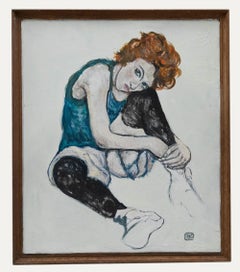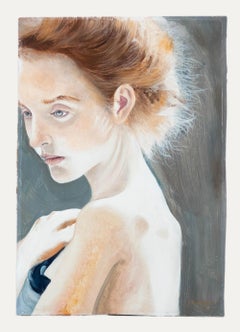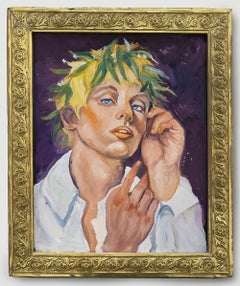Clive Fredriksson Portrait Paintings
to
2
1
1
Overall Width
to
Overall Height
to
1
1
2
2
2
1
1
1
1
2
2
2
280
83
78
76
1
2
Artist: Clive Fredriksson
Clive Fredriksson - 1982 Oil, Pose
By Clive Fredriksson
Located in Corsham, GB
A striking study of a woman a seated woman in a bold pose. Signed with a monogram to the lower right. On board.
Category
20th Century Clive Fredriksson Portrait Paintings
Materials
Oil
$280 Sale Price
20% Off
Clive Fredriksson - 2023 Oil, Woman in Profile
By Clive Fredriksson
Located in Corsham, GB
Signed and dated to the lower right. On board.
Category
21st Century and Contemporary Clive Fredriksson Portrait Paintings
Materials
Oil
$307 Sale Price
20% Off
Related Items
10-11-9 - 21st Century, Contemporary, Nude Painting, Oil on Canvas
By Montse Valdés
Located in Barcelona, Catalonia
“I paint the human figure and explore further till I reach the Beauty of Being, the Soul.. the part of Human Being where everything is in total Serenity, Goodness and Harmony, where ...
Category
21st Century and Contemporary Contemporary Clive Fredriksson Portrait Paintings
Materials
Canvas, Oil
$17,431 Sale Price
20% Off
H 51.19 in W 76.78 in
Early 20th century Art Deco Male nude oil painting of Narcissus
By George Frederick Hinchcliff
Located in Harkstead, GB
An incredibly striking study of the male form with the figure set against a colourful background with stylised organic forms. Attractively framed, the painting is ready to be hung an...
Category
1930s Modern Clive Fredriksson Portrait Paintings
Materials
Oil, Canvas
$1,548 Sale Price
29% Off
H 16 in W 20 in D 2 in
FRANCOIS VAN SEVERDOCK. Portrait of Eugène de Zereso de Cejada. Oil on panel
By Francois Van Severdonck
Located in Paris, FR
Portrait of Eugène de Zereso de Cejada. Oil on mahogany panel.
Eugène de Zereso de Cejada was a Belgian politician and Baron.
Category
Late 19th Century Realist Clive Fredriksson Portrait Paintings
Materials
Oil
$2,824
H 12.21 in W 10.24 in
Venice Landscape Italian Oil on Canvas Painting in Gilt Wood Frame, Belle Epoque
Located in Firenze, IT
This delightful turn of the century (early 20th century) oil on canvas painting represents an Italian landscape with one of the most famous squares in the world: Piazza San Marco in ...
Category
Early 20th Century Impressionist Clive Fredriksson Portrait Paintings
Materials
Canvas, Oil
Venice Landscape Italian Oil on Canvas Painting in Gilt Wood Frame, Belle Epoque, Early 20th Century
$8,385 Sale Price
25% Off
H 51.19 in W 33.47 in D 1.19 in
Portrait of a Lady, After Sir Peter Lely (1610-1680) Oil Painting
By After Sir Peter Lely
Located in Uppingham, GB
Oil Painting After Sir Peter Lely (1610-1680) Portrait of a Lady
Housed in a Lely gold Leaf Frame.
Peter Lely:
In 1647 he became a member of the Pain...
Category
17th Century Old Masters Clive Fredriksson Portrait Paintings
Materials
Oil
$16,690
H 57 in W 47 in D 4 in
11-4-11 - 21st Century, Contemporary, Portrait Painting, Oil on Canvas
By Montse Valdés
Located in Barcelona, Catalonia
“I paint the human figure and explore further till I reach the Beauty of Being, the Soul.. the part of Human Being where everything is in total Serenity, Goodness and Harmony, where ...
Category
21st Century and Contemporary Contemporary Clive Fredriksson Portrait Paintings
Materials
Canvas, Oil
$7,690 Sale Price
20% Off
H 45.67 in W 25.6 in
2-5-17 21st Century, Contemporary, Portrait Painting, Oil on Canvas
By Montse Valdés
Located in Barcelona, Catalonia
“I paint the human figure and explore further till I reach the Beauty of Being, the Soul.. the part of Human Being where everything is in total Serenity, Goodness and Harmony, where ...
Category
21st Century and Contemporary Contemporary Clive Fredriksson Portrait Paintings
Materials
Canvas, Mixed Media, Oil
$20,643
H 59.06 in W 59.06 in D 1.58 in
Portrait of Girl with Flowers by Andrei Belichenko & Maria Boohtiyarova
By Andre Belichenko
Located in Uppingham, GB
A Wonderful Oil on canvas by Andrei Belichenko & Maria Boohityarova. Two excellent Russian artists who have been exhibiting in France, their works are centred around exquisite detail...
Category
2010s Realist Clive Fredriksson Portrait Paintings
Materials
Oil
$14,687
H 44 in W 32 in D 4 in
Cleopatra Queen of Egypt 17' century Painting Oil on Canvas
Located in Rome, IT
Amazing painting of Cleopatra oil on canvas with a gilt wood frame.
Attributed to Giuseppe Diamantini (Fossombrone 1621-Venice 1705)
The dramatic subje...
Category
Late 17th Century Academic Clive Fredriksson Portrait Paintings
Materials
Oil
$56,494
H 48.82 in W 39.38 in D 1.97 in
VAN BIESBROECK Jules. Portrait of a man. Oil sketch on cardboard.
By Jules Pierre van Biesbroeck
Located in Paris, FR
Portrait of a man. Oil sketch on cardboard. Unsigned.
This work will be recorded in the catalogue raisonné of the work of the artist currently in preparation.
Jules Van Biesbroeck was the son of Jules Evariste van Biesbroeck, a painter of Ghent, but was born in Italy, in Portici, near Naples, while his parents were staying there. (In the 19th century many artists made educational trips to Italy). It was a long visit: the child was two years old by the time the family returned to Ghent.[1]
After a short period of practice with his father, van Biesbroeck was enrolled in the Academy of Fine Arts in Ghent. His first painting, "The Shepherd" (French: Le pâtre), was sold at the Triennale in Ghent. In 1888, when he was only 15 years old, he made his debut at the "Salon des Champs-Elysées" in Paris with his monumental work "The Launch of the Argo" (French: Le lancement...
Category
Early 20th Century Impressionist Clive Fredriksson Portrait Paintings
Materials
Oil
$765
H 5.52 in W 3.15 in
6-8-10 - 21st Century, Contemporary, Nude Painting, Oil on Canvas
By Montse Valdés
Located in Barcelona, Catalonia
“I paint the human figure and explore further till I reach the Beauty of Being, the Soul.. the part of Human Being where everything is in total Serenity, Goodness and Harmony, where ...
Category
21st Century and Contemporary Contemporary Clive Fredriksson Portrait Paintings
Materials
Canvas, Oil
$7,263
H 28.75 in W 36.23 in
VAN BIESBROECK Jules. Portrait of a man . Oil sketch on cardboard. Unsigned.
By Jules Pierre van Biesbroeck
Located in Paris, FR
Portrait of a man. Oil sketch on cardboard. Unsigned.
This work will be recorded in the catalogue raisonné of the work of the artist currently in preparation.
Jules Van Biesbroeck was the son of Jules Evariste van Biesbroeck, a painter of Ghent, but was born in Italy, in Portici, near Naples, while his parents were staying there. (In the 19th century many artists made educational trips to Italy). It was a long visit: the child was two years old by the time the family returned to Ghent.[1]
After a short period of practice with his father, van Biesbroeck was enrolled in the Academy of Fine Arts in Ghent. His first painting, "The Shepherd" (French: Le pâtre), was sold at the Triennale in Ghent. In 1888, when he was only 15 years old, he made his debut at the "Salon des Champs-Elysées" in Paris with his monumental work "The Launch of the Argo" (French: Le lancement...
Category
Early 20th Century Impressionist Clive Fredriksson Portrait Paintings
Materials
Oil
Previously Available Items
Clive Fredriksson - Contemporary Oil, A Boy in Blue
By Clive Fredriksson
Located in Corsham, GB
A dynamic composition by Clive Fredriksson, depicting a young boy paused in a crouching position. Signed and dated to the lower left. On canvas on stretchers.
Category
21st Century and Contemporary Clive Fredriksson Portrait Paintings
Materials
Oil
H 29.93 in W 29.93 in
Clive Fredriksson - Contemporary Oil, Portrait of a Boy
By Clive Fredriksson
Located in Corsham, GB
A striking portrait depicting a young man posing with his hands cupped around his face. Unsigned. Presented in an embossed brass frame. On board.
Category
21st Century and Contemporary Clive Fredriksson Portrait Paintings
Materials
Oil
Clive Fredriksson - Contemporary Oil, The Girl in Blue
By Clive Fredriksson
Located in Corsham, GB
A bold portrait of a woman placed in a blue composition. her blue jumper blends seamlessly into the background creating a distorted continuation to her clothing. Unsigned. Presented ...
Category
21st Century and Contemporary Clive Fredriksson Portrait Paintings
Materials
Oil
H 27.56 in W 19.69 in
Clive Fredriksson - Contemporary Oil, Lady In Blue With Peony
By Clive Fredriksson
Located in Corsham, GB
A striking contemporary portrait, showing a waif-like woman in a blue dress, holding a peony against a green background. Unsigned, On canvas.
Category
21st Century and Contemporary Clive Fredriksson Portrait Paintings
Materials
Oil
Clive Fredriksson - Contemporary Acrylic, Portrait of Miles Davis
By Clive Fredriksson
Located in Corsham, GB
A colourful portrait of the famous Jazz musician Miles Davis. Well presented in a contemporary wood frame. Signed. On paper.
Category
21st Century and Contemporary Clive Fredriksson Portrait Paintings
Materials
Acrylic
Clive Fredriksson - Contemporary Oil, British Perch
By Clive Fredriksson
Located in Corsham, GB
A crisp contemporary oil showing a fine British Perch. The artist has signed, dated and inscribed to the lower left and the painting has been presented in a simple wood frame. On board.
Category
21st Century and Contemporary Clive Fredriksson Portrait Paintings
Materials
Oil
Large Oil Painting - Harley Davidson
By Clive Fredriksson
Located in Cirencester, Gloucestershire
Superb large scale oil painting on canvas, depicting this vintage Harley Davidson motor-cycle and female rider. The painting is by the much admired contemporary artist Clive Fredriks...
Category
21st Century and Contemporary Pop Art Clive Fredriksson Portrait Paintings
Materials
Oil
Clive Fredriksson portrait paintings for sale on 1stDibs.
Find a wide variety of authentic Clive Fredriksson portrait paintings available for sale on 1stDibs. You can also browse by medium to find art by Clive Fredriksson in oil paint, paint and more. Not every interior allows for large Clive Fredriksson portrait paintings, so small editions measuring 20 inches across are available. Customers who are interested in this artist might also find the work of Kamsar Ohanyan, Mark Bradley Schwartz, and Gaurango Beshai . Clive Fredriksson portrait paintings prices can differ depending upon medium, time period and other attributes. On 1stDibs, the price for these items starts at $516 and tops out at $712, while the average work can sell for $621.




